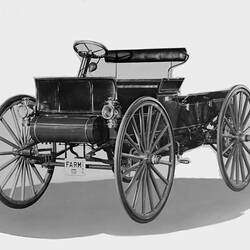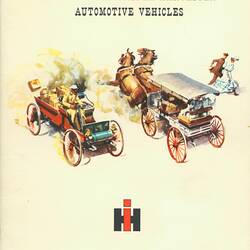Summary
Part of a large collection of glass plate and film negatives, transparencies, photo albums, product catalogues, videos, motion picture films, company journals, advertisements and newspaper cuttings relating to the operations of the International Harvester Company and its subsidiaries in Australia.
The International Harvester Company of America was formed in 1902 by the merger of five leading American agricultural machinery manufacturers. An Australian subsidiary was established in 1904 to manage Australian distribution and sales and over subsequent decades International Harvester became a major competitor to local manufacturers like H.V. McKay's Sunshine Harvester Works. International Harvester also established its own Australian manufacturing works, producing agricultural equipment (and subsequently tractors) at North Shore, Geelong, from 1939, motor trucks at Dandenong, from 1952, and earthmoving and construction equipment at Port Melbourne, from 1958.
The International Harvester 'Auto Buggy' was a 2-cylinder high-wheeled motor vehicle produced by the International Harvester Company of America from 1907 at their factory in Akron, Ohio. It was sold in Australia through International Harvester's local subsidiary from 1909 and was particularly popular with farmers in rural districts because the large 'artillery style' wooden spoked wheels gave excellent ground clearance and were particularly well suited to rough unmade rural roads. The Auto Buggy had an opposed cylinder air-cooled engine mounted underneath the vehicle's body. It ran on petrol and developed 18-20 horsepower, driving the rear wheels through chain drives and a transmission with two forward gears and a reverse gear. It was capable of speeds of 20 to 25 miles per hour (30-40 km/hr). The large 44 and 40-inch diameter wooden-spoked wheels had Sarven pattern hubs with roller bearings and solid rubber tyres. Although originally designed as a passenger vehicle, a commercial version known as the 'Auto Wagon' was also produced with a 'utility' panel box body at the rear offering a freight capacity of up to 750 lbs (340 kg). With a design already outdated when it was introduced, the 'Auto Buggy' was only briefly popular and sales soon declined once cheaper and more modern cars such as the Model T Ford became available. Production of the passenger 'Auto Buggy' ceased by 1912, but the 'Auto Wagon' utility version remained in production until around 1915, when it was replaced by the International F model, the first motor truck of more conventional design from the International Harvester Co.
Description of Content
High-wheel International Harvester Co. 'Auto Buggy' or 'Auto Wagon' fitted with 'utility' body adapted with two longitudinal bench seats in the back and a makeshift roof to operate as an early motor bus. The vehicle has the words 'A.H. TRETHOWAN -+- ARCADIA' painted on the side body panel behind the driver. It is parked beside bluestone kerbing in a suburban street, believed to be in Parramatta, Sydney. To the front and rear of the vehicle are two young plane trees. Behind it is a low stone wall and hedge partially screening a large double-storied brick house, which has verandah and upper balcony featuring ornamental cast-iron lacework balustrades and cast-iron columns. The vehicle has no visible motor registration number plates (first introduced in N.S.W. in 1910). It is fitted with two large acetylene gas headlamps and two smaller coach style kerosene headlamps on the upper dashboard. Mounted on the running-board beside the driver are a toolbox and carbide fuelled gas generator for running the main headlamps. The vehicle was owned by Alfred Ham Trethowan, an orchardist at Arcadia, near Dural, on the north-western outskirts of Sydney and was the first motor truck in the district. Alf used the vehicle to cart fruit and other farm produce to the Hornsby Railway Station, and when fitted out as a bus, to carry passengers down to Parramatta or the City. Mr A.H. Trethowan is seen in the photograph as the driver. Seated behind the steering wheel he is dressed in a trench coat and cap. Behind him are three adult male passengers Mr Arthur Hayes (at rear), Mr Bill Gable and Mr Gilligan. Seated in the passenger seat beside the driver is Mr Eric Carlson, and in front of him is standing a young boy, Dick Trethowan (born 1911), the son of A.H. Trethowan. The photograph is estimated to date from about 1916, based on the apparent age of the boy. Alfred Ham Trethowan was born in The Rocks, Sydney in 1879, the eldest son of Cornish immigrants Alfred Trethowan and Anna Maria (neé Ham), who had arrived in the colony in 1877. Alf Trethowan snr had served an apprenticeship as a shipwright in a family run shipyard in Falmouth, Cornwall, before immigrating, but in Sydney he initially turned his hand to shopkeeping, establishing a Ham and Beef shop with his wife in The Rocks, later moving to shops in Burwood, then Granville, and finally a fruit shop in Parramatta. In 1885, he acquired a 40 acre of property on the corner of Smalls and Blacks Roads, Arcadia, which he developed into a citrus and passionfruit orchard and poultry farm. He campaigned for the construction of the Carlingford to Dural Railway, appearing before a Public Works Committee Inquiry in 1903, at which he complained that it took 7 hours for his horse team to make the 22 mile round trip to Hornsby Station, carting only a 15 cwt (760 kg) load because of the hilly nature of the intervening countryside, making the cost of road freight on his produce equivalent to 6d per case. After Alf Trethowan snr died in 1913, the farm was continued by his son A.H. Trethowan.
Physical Description
Black & white cellulose acetate photographic negative.
More Information
-
Collection Names
International Harvester Photographic Collection, International Harvester (IH) Collection
-
Collecting Areas
-
Acquisition Information
Donation from International Trucks Pty Ltd, by Nov 1992
-
Place & Date Depicted
Parramatta, Greater Sydney, New South Wales, Australia, circa 1916
Note: Image original dated to circa 1913. The date was revised following the receipt of additional information from Caryl Turnidge, 15/06/2016. -
Manufacturer of Item Depicted
International Harvester Co of America Inc, Akron, Ohio, United States of America, circa 1909-1916
-
Creator
International Harvester Co of Australia Pty Ltd (IHC), Victoria, Australia, 12 Feb 1947
Copy neg made on above date. -
Individuals Identified
(left to right):; Hayes, Mr Arthur; Gable, Mr Bill; Gilligan, Mr; Trethowan, Mr A.H. (driver); Carlson, Mr Eric; Trethowan, Dick (boy)
-
Format
Negative, 8" X 6", Black & White
-
Model Name or Number
-
Brand Names
-
Classification
-
Category
-
Discipline
-
Type of item
-
Image Dimensions - Negative/s
210 mm (Width), 162 mm (Height)
-
References
Caryl Turnidge (nee Trethowan), 'The Trethowan Family', Dural and District Historical Society Newsletter, 2016 (see attachment). "Arcadia - Death.", The Cumberland Argus & Fruitgrowers Advocate (Parramatta, NSW), 6 Sept 1913, p.8, <[Link 1]>. "THE PROPOSED DURAL RAILWAY." The Cumberland Argus & Fruitgrowers Advocate (Parramatta, NSW), 24 Oct 1903, p., <[Link 2]>.
-
Keywords
Motor Buggies, Motor Buses, Motor Trucks, Motor Vehicles, Road Transport, Cast Iron Products





